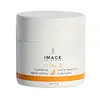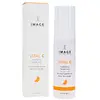What's inside
What's inside
 Key Ingredients
Key Ingredients

 Benefits
Benefits

 Concerns
Concerns

 Ingredients Side-by-side
Ingredients Side-by-side

Aloe Barbadensis Leaf Juice
Skin ConditioningWater
Skin ConditioningGlycerin
HumectantDimethicone
EmollientC12-15 Alkyl Benzoate
AntimicrobialGlyceryl Stearate
EmollientIsostearyl Neopentanoate
EmollientPEG-100 Stearate
Simmondsia Chinensis Seed Oil
EmollientCaprylic/Capric Triglyceride
MaskingCetearyl Alcohol
EmollientCitrus Aurantium Dulcis Oil
MaskingLimonene
PerfumingBrassica Campestris/Aleurites Fordi Oil Copolymer
Skin ConditioningCetyl Alcohol
EmollientTetrahexyldecyl Ascorbate
AntioxidantStearyl Alcohol
EmollientPhenoxyethanol
PreservativeCyclopentasiloxane
EmollientTocopherol
AntioxidantCeteth-10 Phosphate
CleansingDicetyl Phosphate
EmulsifyingMagnesium Ascorbyl Phosphate
AntioxidantPanthenol
Skin ConditioningSqualane
EmollientCaprylyl Glycol
EmollientGlycine Soja Sterols
EmollientLinoleic Acid
CleansingPhospholipids
Skin ConditioningEthylhexylglycerin
Skin ConditioningGlucosamine Hcl
Hexylene Glycol
EmulsifyingXanthan Gum
EmulsifyingMagnesium Aluminum Silicate
AbsorbentPEG-8
HumectantButylene Glycol
HumectantPhytic Acid
Sodium Hydroxide
BufferingPisum Sativum Extract
Skin ConditioningAllantoin
Skin ConditioningRetinyl Palmitate
Skin ConditioningBambusa Vulgaris Leaf/Stem Extract
HumectantCitrus Nobilis Peel Oil
MaskingYeast Polysaccharides
Skin ConditioningDipotassium Glycyrrhizate
HumectantDisodium EDTA
Sodium Hyaluronate
HumectantBenzoic Acid
MaskingAscorbyl Palmitate
AntioxidantPyruvic Acid
MaskingTremella Fuciformis Sporocarp Extract
AntioxidantCitric Acid
BufferingAscorbic Acid
AntioxidantVitis Vinifera Seed Extract
AntimicrobialAloe Barbadensis Leaf Juice, Water, Glycerin, Dimethicone, C12-15 Alkyl Benzoate, Glyceryl Stearate, Isostearyl Neopentanoate, PEG-100 Stearate, Simmondsia Chinensis Seed Oil, Caprylic/Capric Triglyceride, Cetearyl Alcohol, Citrus Aurantium Dulcis Oil, Limonene, Brassica Campestris/Aleurites Fordi Oil Copolymer, Cetyl Alcohol, Tetrahexyldecyl Ascorbate, Stearyl Alcohol, Phenoxyethanol, Cyclopentasiloxane, Tocopherol, Ceteth-10 Phosphate, Dicetyl Phosphate, Magnesium Ascorbyl Phosphate, Panthenol, Squalane, Caprylyl Glycol, Glycine Soja Sterols, Linoleic Acid, Phospholipids, Ethylhexylglycerin, Glucosamine Hcl, Hexylene Glycol, Xanthan Gum, Magnesium Aluminum Silicate, PEG-8, Butylene Glycol, Phytic Acid, Sodium Hydroxide, Pisum Sativum Extract, Allantoin, Retinyl Palmitate, Bambusa Vulgaris Leaf/Stem Extract, Citrus Nobilis Peel Oil, Yeast Polysaccharides, Dipotassium Glycyrrhizate, Disodium EDTA, Sodium Hyaluronate, Benzoic Acid, Ascorbyl Palmitate, Pyruvic Acid, Tremella Fuciformis Sporocarp Extract, Citric Acid, Ascorbic Acid, Vitis Vinifera Seed Extract
Ingredients Explained
These ingredients are found in both products.
Ingredients higher up in an ingredient list are typically present in a larger amount.
Ascorbic Acid is is pure Vitamin C. This form makes up the largest amount of vitamin C found naturally in our skin.
Not only is vitamin C great for your overall health and immune system, it also has plenty of benefits on your skin.
Vitamin C is best used for brightening skin. It improves dark spots, acne scars, and hyperpigmentation. This is because it blocks the process of skin darkening when exposed to UV.
Remember: Vitamin C should not replace sunscreen!
Your skin uses vitamin C to build collagen. Collagen is one key component in having a strong skin barrier and plump skin. Vitamin C also plays a role in regulating collagen, thus making it effective in improving wrinkles and fine lines.
Ascorbic acid shows potent antioxidant activity. As an antioxidant, it helps fight free-radicals. Free-radicals are molecules that may damage your skin cells. These antioxidants also protect skin against UV damage.
The best formulations include Vitamin E and/or ferulic acid. These two ingredients help stabilize and provide a boost in the benefits of ascorbic acid. This is because ascorbic acid becomes unstable when exposed to UV and air. In fact, you can tell your ascorbic acid has oxidized when it turns an orange-yellow color.
Ascorbic acid is generally compatible with other ingredients. However, using ascorbic acid with other active ingredients might cause irritation. Two ingredients: copper ions and benzoyl peroxide, will inactivate ascorbic acid completely.
Read more about other types of Vitamin C:
Foods rich with vitamin C include oranges, strawberries, broccoli, bell peppers, and more. When consuming Vitamin C, your skin receives a portion of the nutrients.
Learn more about Ascorbic AcidCitric Acid is an alpha hydroxy acid (AHA) naturally found in citrus fruits like oranges, lemons, and limes.
Like other AHAs, citric acid can exfoliate skin by breaking down the bonds that hold dead skin cells together. This helps reveal smoother and brighter skin underneath.
However, this exfoliating effect only happens at high concentrations (20%) which can be hard to find in cosmetic products.
Due to this, citric acid is usually included in small amounts as a pH adjuster. This helps keep products slightly more acidic and compatible with skin's natural pH.
In skincare formulas, citric acid can:
While it can provide some skin benefits, research shows lactic acid and glycolic acid are generally more effective and less irritating exfoliants.
Most citric acid used in skincare today is made by fermenting sugars (usually from molasses). This synthetic version is identical to the natural citrus form but easier to stabilize and use in formulations.
Read more about some other popular AHA's here:
Learn more about Citric AcidWater. It's the most common cosmetic ingredient of all. You'll usually see it at the top of ingredient lists, meaning that it makes up the largest part of the product.
So why is it so popular? Water most often acts as a solvent - this means that it helps dissolve other ingredients into the formulation.
You'll also recognize water as that liquid we all need to stay alive. If you see this, drink a glass of water. Stay hydrated!
Learn more about WaterXanthan gum is used as a stabilizer and thickener within cosmetic products. It helps give products a sticky, thick feeling - preventing them from being too runny.
On the technical side of things, xanthan gum is a polysaccharide - a combination consisting of multiple sugar molecules bonded together.
Xanthan gum is a pretty common and great ingredient. It is a natural, non-toxic, non-irritating ingredient that is also commonly used in food products.
Learn more about Xanthan Gum